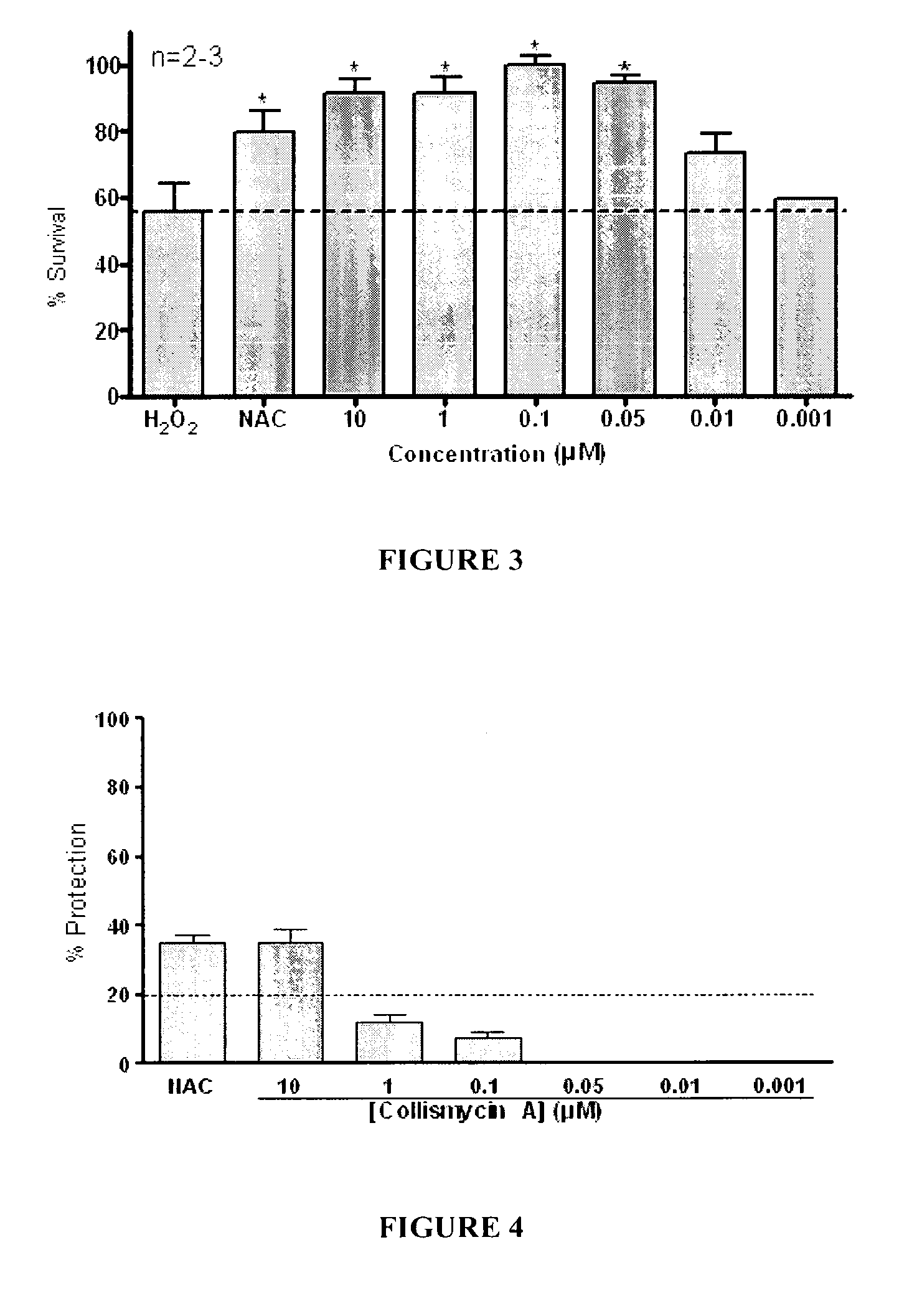Use of Collismycin and Derivatives Thereof as Oxidative Stress Inhibitors
a technology which is applied in the field of collismycin and derivatives, can solve the problems of loss of efficiency, inflammatory reactions, and cell pathological conditions, and achieve the effect of strong oxidative stress inhibition
- Summary
- Abstract
- Description
- Claims
- Application Information
AI Technical Summary
Benefits of technology
Problems solved by technology
Method used
Image
Examples
example 1
Preparation of Compound 1
4-Methylsulfanyl-[2,2′]bipyridinyl-6-carbonitrile
[0064]
First Step Preparation of the intermediate 4-Methylsulfanyl-[2,2′]bipyridinyl 1-oxide
[0065]4-Nitro-[2,2′]bipyridinyl 1-oxide (1.00 g, 4.6 mmol) (D. Wenkert; R. B. Woodward, J. Org. Chem. 1983, 48, 283-289) and sodium methylthiolate (0.73 g, 10.3 mmol) were refluxed in tetrahydrofuran (30 mL) for 6 hours. The mixture was allowed to reach room temperature and the solvent was evaporated in vacuo. The oily residue obtained was redissolved in methylene chloride and washed sequentially with water and a saturated solution of sodium chloride, dried with anhidrous sodium sulfate and evaporated. Pure 4-methylsulfanyl-[2,2′]bipyridinyl 1-oxide was isolated after flash chromatography (SiO2, MeOH / CH2Cl2 1:25) as a yellowish oil that slowly solidified (0.59 g, 59% yield).
[0066]1H NMR (400 MHz, CDCl3):
[0067]8.91, 8.68, 8.14, 7.95, 7.80, 7.32, 7.05, 2.53
[0068]13C NMR (100 MHz, CDCl3):
[0069]149.27, 149.23, 146.41, 139.92...
example 2
Preparation of Compound 2
5-Fluoro-[2,2′]bipyridinyl-6-carbaldehyde oxime
[0075]
First Step Preparation of 5-Fluoro-[2,2′]bipyridinyl-6-carbaldehyde
[0076]To obtain 5-Fluoro-[2,2′]bipyridinyl-6-carbaldehyde, a mixture of 2-Bromo-6 fluoro-6-formylpyridine (2.45 mmol, 0.5 g) and 2-tributylstannyl-pyridine (2.94 mmol; 1.08 g) and Tetrakis(triphenylphosphine)-palladium(0) (0.09 mmol, 0.103 g) in anhydrous toluene was refluxed under nitrogen for 54 h. The resulting brown mixture was evaporated in vacuo and the dark, muddy liquid was dissolved in dichloromethane. The organic phase was washed with aqueous HCl 6M (3×). To remove the product from the solution the combined aqueous layers were transferred dropwise in aqueous ammonia (10%) under cooling. The resulting oil was extracted with dichloromethane (3×). The organic phases were washed with ammonia and water, and the solvent was removed. The resulting crude was purified by column chromatography using as eluent Acetate / Hexane, 1 / 2, thus obtai...
example 3
Preparation of 3-Fluoro-6-pyrazin-2-yl-pyridine-2-carbaldehyde oxime
[0084]
First Step Preparation of 3-Fluoro-6-pyrazin-2-yl-pyridine-2-carbaldehyde
[0085]To obtain 3-Fluoro-6-pyrazin-2-yl-pyridine-2-carbaldehyde, a mixture of 2-Bromo-6 fluoro-6-formylpyridine (2.45 mmol, 0.5 g) and 2-tributylstannyl-pyridine or 2-tributylstannyl-pyrazine (2.94 mmol; 1.00 g) and Tetrakis(triphenylphosphine)-palladium(0) (0.09 mmol, 0.103 g) in anhydrous toluene was refluxed under nitrogen for 54 h. The resulting brown mixture was evaporated in vacuo and the dark, muddy liquid was dissolved in dichloromethane. The organic phase was washed with aqueous HCl 6M (3×). To remove the product from the solution the combined aqueous layers were transferred dropwise in aqueous ammonia (10%) under cooling. The resulting oil was extracted with dichloromethane (3×). The organic phases were washed with ammonia and water, and the solvent was removed. The resulting crude was purified by column chromatography using as ...
PUM
| Property | Measurement | Unit |
|---|---|---|
| Cell death | aaaaa | aaaaa |
| Stress optical coefficient | aaaaa | aaaaa |
Abstract
Description
Claims
Application Information
 Login to View More
Login to View More - R&D
- Intellectual Property
- Life Sciences
- Materials
- Tech Scout
- Unparalleled Data Quality
- Higher Quality Content
- 60% Fewer Hallucinations
Browse by: Latest US Patents, China's latest patents, Technical Efficacy Thesaurus, Application Domain, Technology Topic, Popular Technical Reports.
© 2025 PatSnap. All rights reserved.Legal|Privacy policy|Modern Slavery Act Transparency Statement|Sitemap|About US| Contact US: help@patsnap.com



